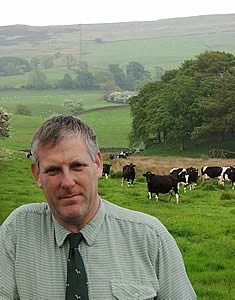 |
|||||||||
|
|||||||||||||||||||
| Herd
Health Planning a Must for Export Markets 25/01/07 Live export markets for both pedigree and commercial cattle may have re-opened - but UK farmers need to take on board herd health planning now to avoid jeopardising these opportunities, warns Graham Brooks, the new president of the British Cattle Veterinary Association.
While cattle farmers in England and Wales face tougher Defra controls this year in continued attempts to eradicate bovine TB, Mr Brooks says producers themselves, in a co-ordinated partnership with universities and other bodies, need to take control of endemic non-zootic diseases such as BVD, IBR and Johnes before the export doors are closed again. Mr Brooks, who specialises in dairy and beef cattle through his Coomara practice at Carleton, Carlisle, and who holds a diploma in bovine reproduction, took over the presidency at the BCVA’s annual congress. A member of the BCVA – which with just under 1,400 members is a specialist division of the BritishVeterinary Association - for more than 20 years since his involvement with the Carlisle practice, he is well aware of the potential problems facing exports. “Personally I think the farming community is going to have to get control and eliminate these diseases before it affects the export trade,” said Mr Brooks. “Already certain parts of Germany and Italy are IBR-free and therefore won’t accept cattle from this country which have been infected with the disease and it’s not going to be long before BVD joins the list. “The agricultural industry will have to take this on board because the government is not going to put in place measures to control it. It’s going to affect both the commercial producer – already large numbers of stirks and older cows are being exported – as well as the pedigree breeder. “Because the majority of farms have not got sufficient bio-security to prevent the spread of infection to neighbouring holdings, it’s not something that can be tackled on an individual farm basis. It has got to be a nationwide industry initiative and we need to find someone to set it up and run it.” Currently the BCVA is supporting a pilot project in Norfolk and Suffolk run by LondonUniversity, one of a number of educational institutions and testing laboratories across the country which could become involved in a co-ordinated scheme which Mr Brooks says the government would probably pump-prime. Reading University is also working on a computer programme to be available in the new year on the cost advantages of individual farm businesses in controlling these diseases. “The BCVA is very concerned about cattle health status in general and the possibility of problems with exports. We all make our living from farmers and we don’t want them to miss out on opportunities to keep their businesses viable.” Producers in England and Wales face increasing costs from additional TB testing which starts on March 1 next year. Figures have shown the incidence of bovine TB has reduced over the last few months in England and Wales although this may be due to the use of a different strain of tuberculin in reactor tests which now has to be imported from Holland when it was previously made in the UK. However, despite the decrease, the law has already set in place the necessity for pre-movement testing of cattle from 42 days of age instead of 15 months from March 1, 2007. Charges for testing are likely to vary widely across the country and Mr Brooks said there was a question over whether the veterinary profession would be able to cope with the extra work. The Government has been running a bovine TB eradication scheme since the 1950s and the disease was virtually eliminated in the 1970s and 1980s. While UK hot spots are in the south west, an increase in the disease in the north west was apparent after herds were re-stocked after foot and mouth in 2001. Mr Brooks said that translocation of cattle was still the most likely cause of spread of the disease in Cumbria as, in most cases of a reactor, there had not been a herd breakdown within the following six to nine months. * The son of a builder from Middlesbrough where his boyhood ambition of becoming an agricultural vet was inspired by caravanning holidays on a farm and the James Heriot stories, Graham Brooks left the Royal Veterinary College, London, with a Bachelor degree in veterinary medicine. He took up his first appointment in Blackburn where he met his wife-to-be Lynne and 18 months later in 1993 he joined the Coomara Practice in Cumbria, becoming a partner in 1989 and then sole partner in 1999. Now he and Lynne, who deals with administrative work, run the practice which is 70 per cent farm work covering north Cumbria and the south of Scotland with the remainder dealing with horses and small animals. They employ two full-time and three part-time vets, two full-time qualified veterinary nurses, a full-time administrator and four part-time reception staff. “It’s an honour to be asked to take on the role and during my year in office I hope to be able to put something back into the profession,” said Mr Brooks, who has been a member of the BCVA’s council since September 2001. © Copyright 2007 Jennifer MacKenzie All Rights Reserved.
|
|||||||||||||||||||

|
|
||||||||||||||||||
| home | agri-services | pedigree
pen | news | dairy | beef | machinery property | organisations | site map |
|||||||||||||||||||

Article by
Jennifer MacKenzie
